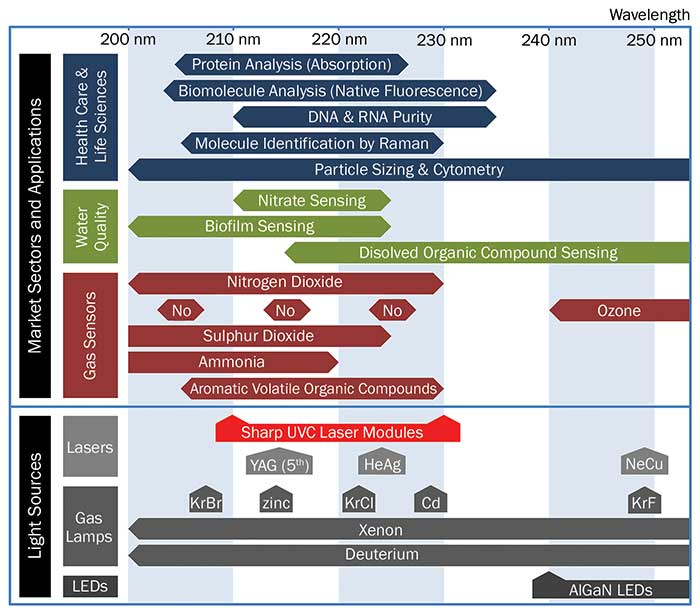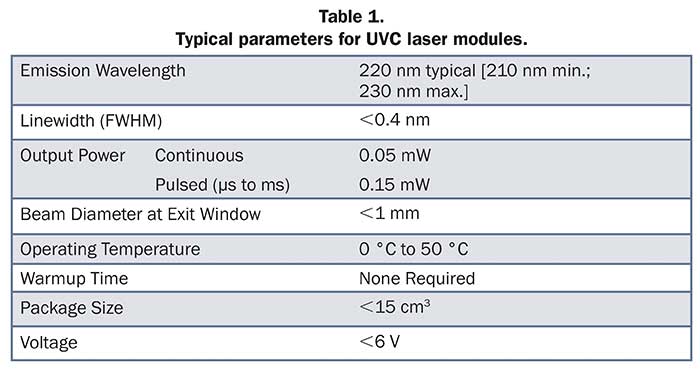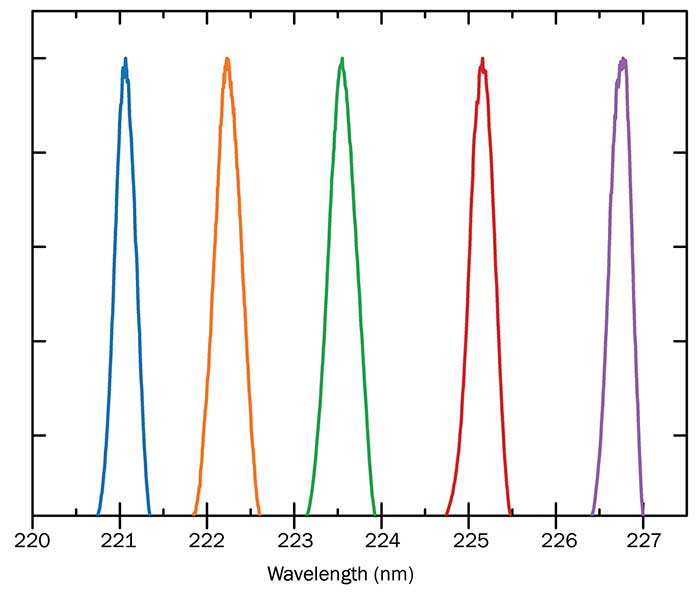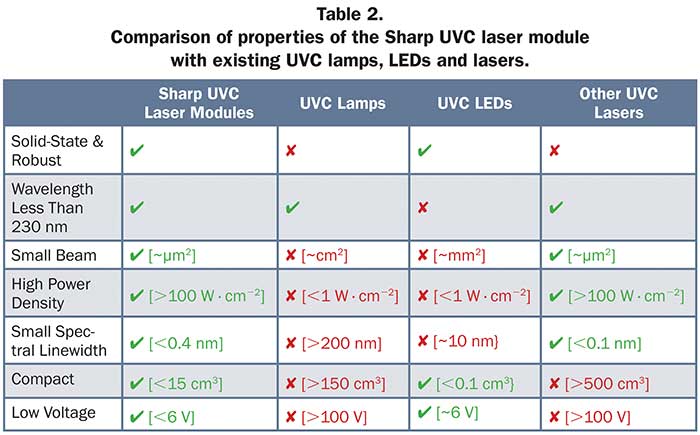A novel solid-state laser technology for wavelengths near 220 nm overcomes limitations of current-generation UV lasers and gas discharge lamps.
TIM SMEETON, KARL WELNA, EDWARD BOARDMAN, RISHANE PEREIRA, VALERIE BERRYMAN-BOUSQUET, SHARP LABORATORIES OF EUROPE LTD.
Advances in sensor technologies and the more widespread deployment of sensors are continually improving safety, quality of life and industrial productivity. Many of the most reliable chemical, biological and gas sensors are in some way based on light, with current technology exploiting wavelengths from deep ultraviolet to far infrared. Within this field, ultraviolet light with wavelengths between 210 and 230 nm in the ultraviolet C (UVC) spectral range has a vital role because of the strong and specific interaction between these wavelengths and many analytes, especially those measured during medical diagnosis, life sciences research, drinking water production and gas analysis.
 Sensor technologies that need this ultraviolet light include instrumentation for identification and quantification of proteins and other organic molecules, sensors for organic compounds and nitrates in water, and sensors for several gases important for emissions and air quality analysis (Figure 1). These technologies rely on measurements of absorption, induced-fluorescence or scattering of the 210- to 230-nm wavelengths that, in current technology, must be generated using gas discharge lamps or complex laser systems (Figure 1, bottom). Gas discharge lamps currently dominate this field — especially deuterium lamps and xenon flash lamps, which emit a continuum of wavelengths between 200 and 400 nm and are filtered to provide emission in a specific wavelength range. Laser sources are advantageous or essential for many sensors, thanks to the high spectral purity or spatial quality of a laser beam. However, the few wavelengths available and very high cost of existing gas lasers and complex frequency-converted lasers mean that exploitation of laser-based sensors is limited to niche markets.
Sensor technologies that need this ultraviolet light include instrumentation for identification and quantification of proteins and other organic molecules, sensors for organic compounds and nitrates in water, and sensors for several gases important for emissions and air quality analysis (Figure 1). These technologies rely on measurements of absorption, induced-fluorescence or scattering of the 210- to 230-nm wavelengths that, in current technology, must be generated using gas discharge lamps or complex laser systems (Figure 1, bottom). Gas discharge lamps currently dominate this field — especially deuterium lamps and xenon flash lamps, which emit a continuum of wavelengths between 200 and 400 nm and are filtered to provide emission in a specific wavelength range. Laser sources are advantageous or essential for many sensors, thanks to the high spectral purity or spatial quality of a laser beam. However, the few wavelengths available and very high cost of existing gas lasers and complex frequency-converted lasers mean that exploitation of laser-based sensors is limited to niche markets.
 Figure 1. Wavelengths required for existing and emerging sensors based on deep ultraviolet light and available light source technology. Courtesy of Sharp Laboratories of Europe Ltd.
Figure 1. Wavelengths required for existing and emerging sensors based on deep ultraviolet light and available light source technology. Courtesy of Sharp Laboratories of Europe Ltd.
There is a strong pull from sensor developers to move away from reliance on gas lamps and complex laser systems and adopt more practical compact solid-state alternatives. The advantages of solid-state light sources are well known, and include lower system costs, lower total ownership costs, smaller size, improved robustness, low-voltage operation, lower energy consumption, longer lifetimes and resilience to frequent on-off cycling. These features can enable significant improvements in sensor functionality and, more importantly, enable the migration of technologies that are presently only viable in high-cost applications to more affordable and widespread use.
A recent example of the impact of new solid-state light sources on photonic sensors can be seen in technologies enabled by LEDs emitting wavelengths between 240 and 320 nm. New sensors to measure dissolved organic compounds in water using wavelengths near 255 nm and for protein analysis with wavelengths near 280 nm are evidence of the trend away from the gas lamp sources that were previously incumbent. Theoretically, similar LED technology is applicable to wavelengths below 230 nm, but severe technical challenges associated with operation at these shorter wavelengths — difficulties in semiconductor doping, in particular— have prevented viable LED operation in the 210- to 230-nm range, and laser diodes for these wavelengths seem to be, at best, a distant prospect.
This leaves an unsatisfied need for a new-generation light source to bring the benefits of solid-state devices to the 210- to 230-nm wavelength range for the first time, and to enable wider penetration of laser-based sensor technologies.
Sharp Laboratories of Europe has developed a UVC laser module technology
that meets these needs and creates exciting opportunities for sensor
technologies based on deep ultraviolet laser light.

Figure 2. Underlying concept of the UVC laser module. Courtesy of Sharp Laboratories of Europe Ltd.
UVC laser module
The new laser modules provide laser emission with a wavelength near 220 nm from solid-state technology in a compact package with highly practical operating conditions. Blue light emitted from a laser diode is frequency-doubled to generate an output wavelength near 220 nm and a high-performance, compact wavelength filter ensures pure ultraviolet emission (Figure 2). A proprietary design overcomes the critical challenges associated with frequency-doubling laser diodes at these wavelengths to provide modules with high output power, excellent temporal stability and a wide operating temperature range in a compact package.

The UVC laser modules are designed to deliver technical performance meeting the requirements for sensor technologies (Table 1). Laser modules can be produced with an emission wavelength anywhere between 210 and 230 nm, enabling precise matching with the wavelengths required for specific applications (Figure 3). The emission wavelength of a module is either tuneable over ±0.5 nm through modulation of temperature or injection current, or may be fixed at manufacturing to remain within ±0.1 nm during service. The modules may be operated for modes ranging from microsecond duration pulses through to CW, providing output powers up to 0.15 mW, which are suitable for absorption, induced-fluorescence and scattering applications. The ultraviolet emission is in a linearly polarized collimated beam, enabling high-efficiency transmission through optical systems, and the beam may be focussed with simple, low-loss optical components to provide extreme power densities — for example, exceeding 100 W·cm-2 in a 10-µm-diameter spot. The lasers operate by direct electrical current injection for temperatures between 0 °C and 50 °C without needing any warmup time, thereby enabling simple and low-cost integration into instrumentation ready for operation in the field. The laser technology is proven to be reliable and robust, with operating lifetimes exceeding several thousand hours demonstrated. The highly compact UVC laser module package features an external volume less than 15 cm3, similar to the size of an AA battery.
 Figure 3. Laser emission spectra from five different UVC laser modules from 220 to 227 nm. Modules can be produced with an emission wavelength anywhere between 210 and 230 nm. Courtesy of Sharp Laboratories of Europe Ltd.
Figure 3. Laser emission spectra from five different UVC laser modules from 220 to 227 nm. Modules can be produced with an emission wavelength anywhere between 210 and 230 nm. Courtesy of Sharp Laboratories of Europe Ltd.
UVC laser modules have significant advantages over existing light sources for sensor technologies (Table 2), providing a unique combination of small spectral linewidth, laser beam quality, high power density, practical operating conditions and emission wavelength below 230 nm. This combination has a disruptive impact on many sensor technologies (Figure 1), creating many new opportunities.

Opportunities for health care and the life sciences
Analysis of proteins and biomolecules is a cornerstone of life sciences research and health care. Wavelengths near 220 nm are essential for identifying and quantifying proteins and other biological molecules, and the UVC laser module brings new opportunities in several areas:
• High-performance liquid chromatography (HPLC) and capillary electrophoresis (CE) techniques widely use absorption of wavelengths near 220 nm for detection, generally using gas discharge lamps. Wavelengths near 214 nm are standard for protein and peptide analysis because they are very strongly absorbed, enabling at least 20 times higher sensitivity compared with 280-nm wavelengths. UVC laser modules provide opportunities for significant improvements to these systems including lower cost, smaller size, longer operating lifetime, battery operation and operation without warmup. There is also the potential for improved functionality, such as improved linearity of absorbance versus concentration thanks to the narrow spectral linewidth of the laser emission.
• Laser-induced native fluorescence (LINF) is a powerful technique for analysis of biomolecules that have not been modified by labeling with fluorescent marker molecules. Laser light with wavelengths near 220 nm induces fluorescence from these molecules almost universally, creating myriad opportunities. These are currently only exploited in niches due to the constraints of available laser sources. UVC laser modules enable this technique to be deployed widely without reliance on bench-top laser systems.
• Point-of-care diagnosis tools for analysis of proteins or other biomolecules can exploit laser wavelengths near 220 nm
for the first time with UVC laser modules. For example, deep ultraviolet absorption and fluorescence processes that are conventionally available only in laboratories may now be incorporated into emerging diagnostic technologies. This meets the trend to improve the quality and efficiency of health care with medical diagnosis at the patient point of care.

Tracking water pollutants
Chemical sensors based on optical absorption, fluorescence and scattering provide market-leading stability, accuracy and reliability for the water industry. UVC laser modules enable performance improvements and more widespread use of optical-based sensors for this sector:
• Organic pollutants in water and biofilms on surfaces can be detected and quantified with high specificity from the fluorescence induced by ultraviolet light. The high beam quality, high power density and small spectral linewidth of laser light enable efficient fluorescence sensors with simple optical designs and with no interference from the input beam. Wavelengths near 220 nm are highly effective at inducing fluorescence and also make it possible to distinguish between families of organic molecules. For example, molecules containing many aromatic rings — polycyclic aromatic hydrocarbons (PAHs) — have characteristic fluorescence for input wavelengths in the 220- to 230-nm range. These phenomena have long been used inside laboratories, and the UVC laser modules provide an opportunity for widespread exploitation in the field.
• Nitrate sensors for water using absorption of wavelengths near 220 nm are the preferred technology in wastewater treatment, drinking water production and monitoring agricultural fertilizer pollution of natural waters1. Most sensors use xenon flash lamps with wavelength filters to isolate wavelengths around 220 nm. UVC laser modules enable lower manufacturing and operating costs thanks to simpler and safer optical designs and improved reliability. Furthermore, operation of UVC laser modules without warmup time enables remarkably lower power consumption suitable for battery-powered environmental monitoring. These improvements can help the water industry and environmental monitoring sectors realize their vision for much more widespread monitoring.
High-performance gas sensors
Monitoring pollutant gases is an important part of measures to improve air quality and reduce disease caused by exposure to harmful compounds in the air. Laser-based gas sensors provide sensitivity, long-term accuracy and specificity unmatched by other technologies, but require availability of lasers at specific wavelengths. These new UVC laser modules provide the first widely useable source of several wavelengths that are important for gas sensing:
• Emissions gases nitric oxide (NO), nitrogen dioxide (NO2), sulphur dioxide (SO2) and ammonia (NH3) all have strong absorption features in the 210- to 230-nm wavelength range. The narrow spectral linewidth of the UVC laser modules, and the option for modules with tuneable or fixed emission wavelength, enables precise alignment with these features. Most importantly, these laser-based sensor technologies can be deployed widely for the first time, for example for indoor air quality applications.
• Volatile organic compounds also have strong absorption for wavelengths near 220 nm, so the UVC laser module similarly enables novel sensor technologies for these, based on absorption and fluorescence.
Outlook
The UVC laser modules are the first laser sources for wavelengths in the 210- to 230-nm range that are suitable for widespread use. They also represent the first viable compact solid-state light sources of any type in this wavelength range. This technology enables a transition away from reliance on gas discharge lamps and complex laser systems in sensors and consequently creates opportunities for disruptive improvements in sensor performance. This can lead to migration of proven sensor concepts to widespread use and stimulate development of entirely new sensor technologies.
Meet the authors
Tim Smeeton is a chief technologist at Sharp Laboratories of Europe, specializing in development of new photonic devices; email: [email protected].
Karl Welna is a senior researcher at Sharp Laboratories of Europe; email: [email protected].
Edward Boardman is a senior researcher at Sharp Laboratories of Europe; email: [email protected].
Rishane Pereira is a research engineer at Sharp Laboratories of Europe; email: [email protected].
Valerie Berryman-Bousquet is a research manager at Sharp Laboratories of Europe; email: [email protected].
Reference
1. American Public Health Association. (1992). American Public Health Association Standard 4500-NO3--B, https://law.resource.org/pub/us/cfr/ibr/002/apha.method.4500-no3.1992.pdf.